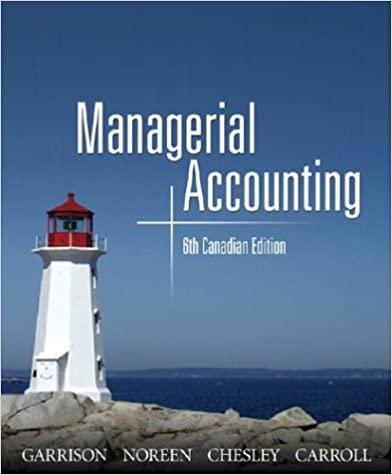Question
Inventories Explain the definition of inventories. Identify major classification of inventory. Explain how to initially recognize and measure inventories. Explain what costs are included in
Inventories
- Explain the definition of inventories.
- Identify major classification of inventory.
- Explain how to initially recognize and measure inventories.
- Explain what costs are included in the cost of inventories.
- Determine the goods included in inventory and effects of inventory errors on the financial statements.
- Distinguish between perpetual and periodic inventory systems.
- Account for inventory transactions using both the periodic and the perpetual methods.
- Explain and apply end-of period procedures for inventories under both the periodic and the perpetual methods.
- Explain why cost flow assumptions are required and apply both the FIFO and weighted average cost formulas.
- Explain the net realizable value basis of measurement and account for adjustments to net realizable value.
- Account for inventories expense.
- Determine ending inventory by applying the gross profit method.
- Determine ending inventory by applying the retail inventory method.
- Discuss accounting issues related to purchases commitments.
- Enumerate and illustrated the presentation and disclosure requirements of PAS 2.
Agriculture
1.Explain the background to the development of PAS 41.
2.Distinguish between agricultural activities, agricultural produce and biological assets.
3.Explain the different accounting treatment required before and after harvest.
4.Explain the recognition criteria for biological assets and agricultural produce.
5.Analyze the meaning of 'fair value' when applied to biological assets and agricultural produce.
6.Explain the practical implications of measuring these assets at fair value, including interpreting the disclosures made by companies applying the standard.
7.Examine the interaction between PAS 41 and
PAS 20 Accounting for Government Grants and Disclosure of Government Assistance.
8.Examine the interaction between PAS 41 and
PAS 16 Property, Plant and Equipment and PAS 40 Investment Property.
9.Describe the disclosure requirements of PAS 41.
10.apply the recognition and measurement requirements of PAS 41 to a simple statement of profit or loss and other comprehensive income and statement of financial position.
Property, Plant and Equipment
1.Define the term "property, plant and equipment" in accordance with PAS 16.
2.State the criteria which must be satisfied for an item of property, plant and equipment to be recognized as an asset.
3.Determine the cost of an item of property, plant and equipment.
4.Explain the requirements of PAS 23 in relation to borrowing costs incurred for the acquisition, construction or production of a qualifying asset.
5.Explain the requirements of PAS 20 in relation to government grants.
6.Distinguish between the cost model and the revaluation model for the measurement of property, plant and equipment after initial recognition.
7.Calculate and account for depreciation charges in accordance with PAS 16.
8.List the main disclosures required by PAS 16.
Continuation of PPE
1.Define the term "impairment loss".
2.List the main factors which may indicate that an asset is impaired.
3.Calculate the recoverable amount of an asset and the amount of any impairment loss.
4.Explain the accounting treatment of impairment losses.
5.Define the term "cash-generating unit" and explain how such units are identified.
6.Allocate an impairment loss amongst the assets of a cash-generating unit.
7.Account for the reversal of an impairment loss.
8.List the main disclosure requirements of PAS 36.
Exploration and evaluation Assets
1.Explain the context of mineral resources and that entities involved in extractive activities are often faced with unique and challenging accounting issues.
2.Describe the objective of PFRS 6.
3.Apply the necessary judgement in determining the nature of the activities and related costs considered to be within the limited scope of PFRS 6.
4.Evaluate the accounting policy options available for exploration and evaluation assets under PFRS 6.
5.Analyze costs incurred during the exploration and evaluation phase of extractive activities in order to apply the area of interest method as set out in PFRS.
6.Demonstrate understanding of the presentation requirements of PFRS 6 and industry practices.
7.Evaluate the appropriateness of continued capitalization of costs incurred during the exploration and evaluation phase of extractive activities.
8.Apply the disclosure requirements of PFRS 6.
9.Discuss the possible future developments related to accounting for the extractive industries.
Investment Property and Non current Assets Held for sale
1.Discuss the way in which the treatment of investment properties differs from other properties.
2.Apply the requirements of PAS 40 to investment properties.
3.Correctly classify non-current assets as either held for use or held for sale, in accordance with the requirements of PFRS 5.
4.Explain the concept of a "disposal group".
5.Correctly measure non-current assets (or disposal groups) held for sale.
6.State the main presentation and disclosure requirements of IFRS5 with regard to non-current assets held for sale and discontinued operations.
Intangible assets and GoodWill
1.Describe the characteristics of intangible assets.
2.Discuss the recognition criteria applied to intangible assets.
3.Identify the costs to include in the initial valuation of intangible assets.
4.Explain the procedure for amortizing intangible assets.
5.Explain the accounting issues for recording goodwill.
6.Explain the accounting for intangible assets subsequent to initial recognition.
7.Explain the accounting issues related to intangible asset impairments.
8.Identify the conceptual issues related to research and development costs.
9.Describe the accounting for research and development and similar costs.
10.Indicate the presentation of intangible assets and related items.
11.Enumerate and illustrate the disclosures required for intangible assets.
Fund and Other Investments
1.Explain the nature and purpose of fund.
2.Distinguish between current fund and noncurrent fund.
3.Account for sinking fund.
4.Determine the annual contribution to the sinking fund.
5.Account for other noncurrent fund such as preference share redemption fund, plant expansion fund, contingency fund, and insurance fund.
6.Account for cash surrender value of life insurance policy.
Step by Step Solution
There are 3 Steps involved in it
Step: 1

Get Instant Access to Expert-Tailored Solutions
See step-by-step solutions with expert insights and AI powered tools for academic success
Step: 2

Step: 3

Ace Your Homework with AI
Get the answers you need in no time with our AI-driven, step-by-step assistance
Get Started


